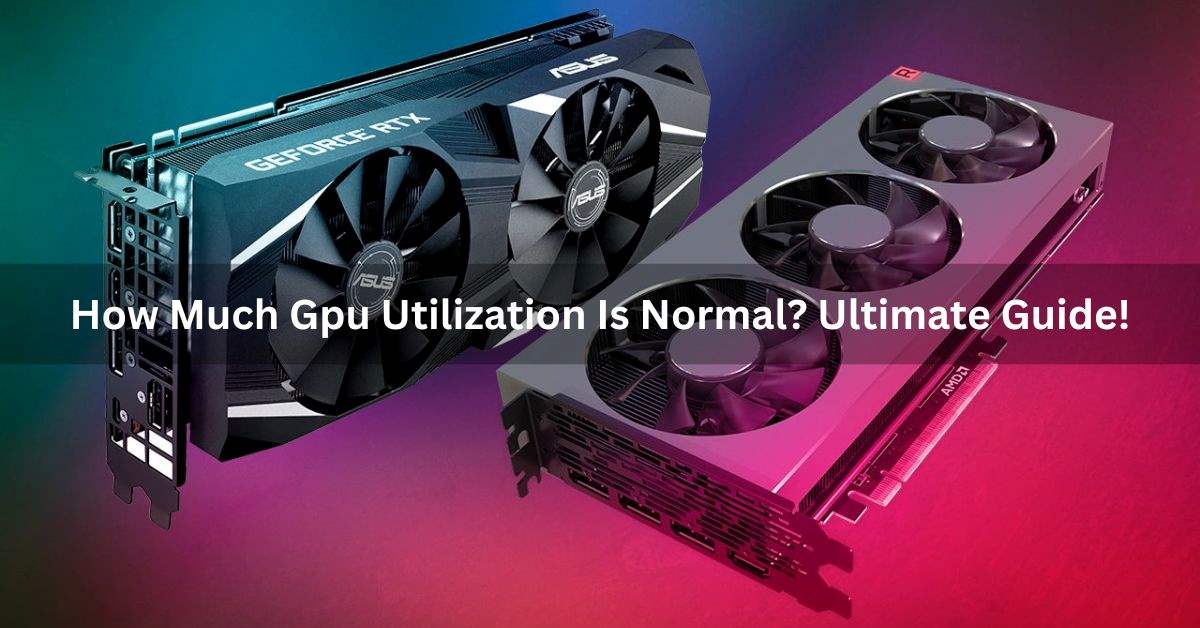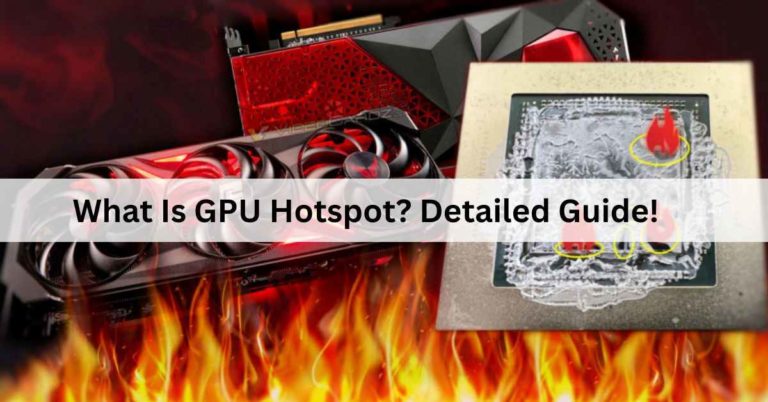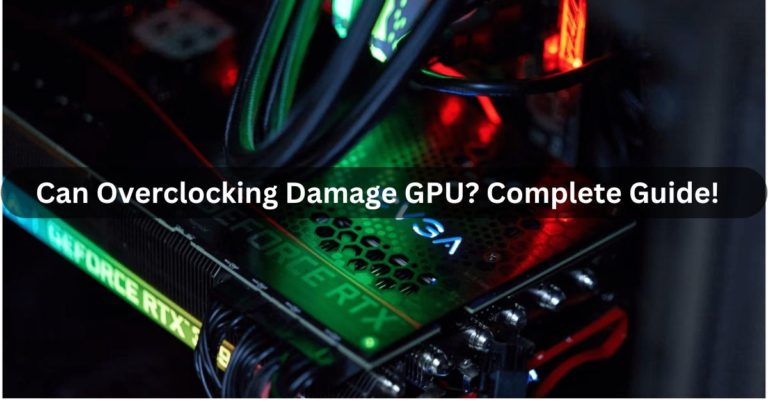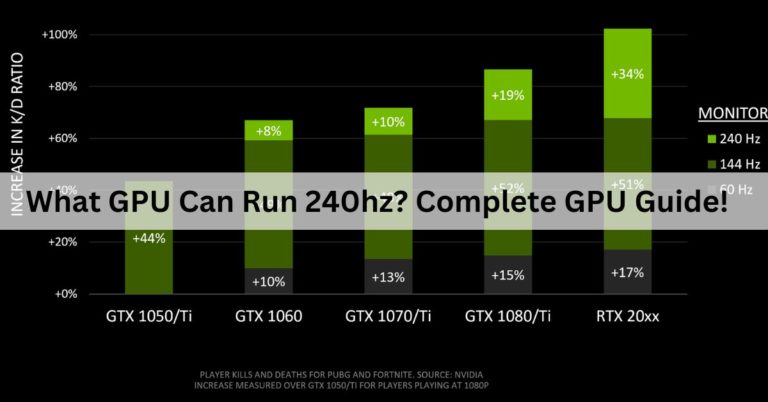How Much Gpu Utilization Is Normal? Ultimate Guide!
In the world of computing, the Graphics Processing Unit (GPU) plays a pivotal role in handling graphics-related tasks.
Normal GPU utilization can vary depending on the task. During typical desktop usage, it may be low, around 10-20%. In intensive tasks like gaming or rendering, 80-100% is common. Efficient usage matches the task’s demands.
In this article, we’ll explore GPU utilization, why it matters, what’s considered normal, and how to optimize its usage.
What Is GPU Utilization?
GPU utilization refers to the extent to which a GPU is being used to perform tasks. It’s a measure of how busy the GPU is at any given time. This percentage reflects the ratio of time the GPU spends on actual processing as compared to idle time.
Why Is GPU Utilization Important?
Understanding GPU utilization is crucial for several reasons. It allows you to:
- Monitor the performance of your GPU.
- Identify potential bottlenecks in your system.
- Optimize resource allocation for efficient task execution.
Understanding GPU Load:
GPU load is a term closely related to utilization. It quantifies the amount of work the GPU is currently performing. A high load indicates that the GPU is actively processing tasks, while a low load suggests it’s underutilized.
Also read: What Is GPU In Computer? Ultimate Guide!
Normal GPU Utilization:

The normal GPU utilization can vary depending on the type of workload. In general, for everyday tasks like web browsing or word processing, a GPU may have minimal utilization, often less than 10%.
For gaming, you can expect GPU utilization to range from 30% to 90%, depending on the game’s graphics demands. Workstation tasks like 3D rendering or video editing may utilize the GPU up to 100%.
Factors Affecting GPU Utilization:
Several factors influence GPU utilization:
Software:
GPU utilization is driven by the software you’re using. Graphics-intensive applications will utilize the GPU more.
Hardware:
The capabilities of your GPU, such as the number of cores, clock speed, and memory, impact utilization.
Resolution and Settings:
Higher resolutions and graphics settings in games or applications will demand more GPU power.
Importance of Optimizing GPU Usage:
Optimizing GPU usage can enhance overall system performance, extend the lifespan of your GPU, and reduce energy consumption. Ensuring efficient utilization of your GPU can also lead to a smoother and more enjoyable gaming experience.
Also read: What is a reference gpu? A Comprehensive Guide!
Understanding GPU Utilization:
GPU utilization measures the percentage of a graphics processing unit’s capacity being actively used for computation. Higher utilization indicates more efficient and intensive processing, while low utilization may suggest underutilization or system bottlenecks.
How to Monitor GPU Utilization?
To monitor GPU utilization, use system monitoring tools like NVIDIA’s GPU monitor, MSI Afterburner, or built-in OS utilities. They display real-time GPU usage, temperature, and performance metrics, helping you track and optimize GPU performance.
Also read: Do GPU fans always spin? – Causes And Fixed – 2023
Low GPU Utilization Causes:
Low GPU utilization can be caused by various factors:
1. Insufficient workload:
Inadequate tasks or inefficient software may not fully utilize the GPU’s capabilities.
2. CPU bottleneck:
Slow CPU performance can limit data transfer to the GPU, reducing utilization.
3. Memory limitations:
Limited VRAM can restrict GPU usage, especially in memory-intensive applications.
4. Driver issues:
Outdated or incompatible drivers can hinder GPU performance.
5. Power settings:
Power-saving configurations may throttle GPU usage to save energy.
6. Background processes:
Other applications using the GPU can reduce its availability for a specific task.
High GPU Utilization Causes:
High GPU utilization can result from various factors:
1. Resource-intensive tasks:
Running demanding applications like 3D rendering or machine learning can max out GPU usage.
2. Multitasking:
Running multiple GPU-intensive tasks simultaneously can lead to high utilization.
3. Inefficient code:
Poorly optimized software or algorithms can push the GPU to its limits.
4. Overclocking:
Aggressive GPU overclocking can increase utilization but may risk stability.
5. Background processes:
Hidden tasks using GPU resources can drive up utilization.
6. GPU-bound scenarios:
Applications that rely heavily on the GPU for rendering or computation can naturally result in high utilization.
Why Is My GPU Usage So Low?
Low GPU utilization often arises due to several factors. One common cause is an insufficient workload or inefficient software that doesn’t fully utilize the GPU’s capabilities.
Another key factor can be a CPU bottleneck, where a slow CPU limits data transfer to the GPU, preventing it from reaching its potential. Limited VRAM (video memory) can also lead to low GPU usage, particularly in memory-intensive applications.
Outdated or incompatible GPU drivers can be a significant hindrance, as can power-saving settings that throttle GPU usage to save energy.
Additionally, background processes or running multiple GPU-intensive applications simultaneously can reduce the GPU’s availability for the current task. Identifying and addressing these issues is crucial to increasing GPU usage when necessary.
Also read: Pytorch Check If GPU Is Available? Complete Guide!
Is 100% GPU Usage Bad or Good?

100% GPU usage can be both good and bad. It’s good when your GPU is fully utilized during demanding tasks like gaming or rendering, maximizing performance.
However, sustained 100% usage for extended periods can lead to overheating and reduced GPU lifespan, which is not ideal.
Is High GPU Usage and Low CPU Usage any Good?
High GPU usage and low CPU usage can be good, depending on the task. It suggests that your GPU is efficiently handling the workload, which is beneficial for tasks like gaming, video editing, or GPU-accelerated applications.
However, for CPU-dependent tasks, low CPU usage may indicate underutilization.
Also read: Can I Bring A Gpu On A Plane? Ultimate Guide!
GPU Utilization in Different Applications?
GPU utilization varies across different applications, with the level of usage depending on the specific demands of each task. In gaming, high GPU usage is common as it is essential for smooth graphics rendering and ensuring a satisfying gaming experience.
What Should Your GPU Utilization Be During Regular Use?
During regular use, such as web browsing, office tasks, and media consumption, GPU utilization should generally be low, typically below 10-20%.
Higher usage is expected during tasks like gaming or video editing, where the GPU handles more intensive graphics and rendering processes.
What Should Your GPU Utilization Be During Gaming?
During gaming, it’s ideal for GPU utilization to be higher, often in the range of 90-100%. This level of usage indicates that the GPU is fully engaged in rendering graphics and delivering a smooth gaming experience.
What Should Your GPU Utilization Be During Video Editing or 3D Rendering?
During video editing and 3D rendering tasks, it’s beneficial to have a high GPU utilization, often in the range of 80-100%.
This level of usage signifies that the GPU is efficiently accelerating the rendering and processing of complex visuals, leading to faster and smoother editing or rendering workflows.
Concerns of Long-Term GPU Utilization:
Long-term GPU utilization can raise concerns related to heat and wear. Continuous high usage may lead to increased temperatures, potentially affecting hardware longevity. Ensure proper cooling, monitor temperatures, and consider occasional breaks to maintain optimal GPU health.
Is 80 C too hot for GPU?

A GPU temperature of 80°C is generally considered within an acceptable range during heavy load, especially for modern GPUs. Many GPUs are designed to operate at temperatures up to 90-95°C without causing damage.
However, lower temperatures are preferable for prolonged GPU lifespan and optimal performance. You may consider improving cooling or airflow if your GPU regularly exceeds 80°C.
How to FIX LOW GPU USAGE While GAMING in 2023?
If you’re experiencing low GPU usage while gaming in 2023, there are several steps you can take to address the issue.
First, make sure your graphics drivers are up-to-date, as manufacturers often release updates that include performance improvements.
Adjust in-game settings to increase the graphics load on your GPU, ensuring it operates closer to its full capacity.
Additionally, monitor and close unnecessary background applications that might divert system resources from the GPU during gaming.
Is My CPU Bottlenecking My GPU?
To determine if your CPU is bottlenecking your GPU, monitor their usage while running demanding tasks, such as gaming or rendering.
If the CPU consistently operates at or near 100% usage while the GPU remains underutilized, it’s likely a bottleneck. Upgrading the CPU or adjusting in-game settings may be necessary to balance performance.
Is 90 CPU usage bad while gaming?
A CPU usage of 90% while gaming can be considered high but isn’t necessarily bad, as it depends on the specific CPU and game. Some games are more CPU-intensive than others.
Ideally, your CPU usage should stay below 100% to ensure smooth performance and prevent potential bottlenecks.
If you consistently experience 90% CPU usage and it’s affecting game performance, you might benefit from a CPU upgrade or adjusting in-game settings to reduce the CPU load.
Tips for Maintaining Optimal GPU Performance:
- Keep your GPU drivers up to date.
- Ensure proper ventilation and cooling for your GPU.
- Adjust in-game settings to balance performance and quality.
- Close unnecessary background applications to free up GPU resources.
5% CPU, 95% GPU in games. Is that normal?
Yes, a distribution of 5% CPU and 95% GPU usage in games can be considered normal, especially if the game is graphics-intensive.
Many modern games rely heavily on GPU processing for rendering and graphics tasks, while the CPU handles other computations. This balance indicates efficient utilization of hardware resources.
How to Fix 100% GPU Usage When Idle?
To fix 100% GPU usage when idle, check for background processes or applications causing the issue. Update GPU drivers, adjust power settings to balance performance, and monitor task manager for resource-heavy applications.
Additionally, ensure your system is free from malware, as malicious programs can cause unnecessary GPU load.
How Much GPU Usage is Normal?
Normal GPU usage varies depending on the task. For casual desktop use, 0-5% is common. In gaming, it can range from 30-100%, depending on the game’s graphics demands.
Video editing or 3D rendering may push usage to 100%. Efficient systems often balance GPU load based on the application’s requirements.
Is 100% GPU Usage Always Good?
No, 100% GPU usage isn’t always ideal. While it’s normal during resource-intensive tasks like gaming or rendering, constant full usage might indicate inefficiency or bottleneck issues.
Ideally, systems should dynamically adjust GPU load based on application needs, ensuring optimal performance without unnecessary strain on the hardware.
Is GPU usage at 98% ideal ?
A GPU usage of 98% can be ideal during demanding tasks like gaming or rendering, as it indicates efficient utilization of the hardware.
However, in some cases, it might suggest a potential bottleneck or resource-intensive process. Monitoring temperatures and overall system performance can help assess whether it’s within acceptable limits.
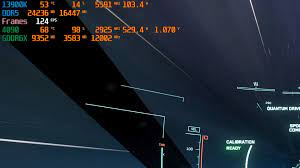
Frequently Asked Questions:
1. How much GPU usage is normal for gaming?
Normal GPU usage for gaming typically falls in the range of 70% to 100%. It can vary depending on the game’s complexity and your hardware capabilities.
2. Why is GPU only 3% usage during gaming?
A GPU running at 3% usage during gaming suggests an issue, possibly with the game not properly utilizing the GPU. Check game settings, drivers, and system performance for potential solutions.
3. Is 50 CPU usage normal?
A CPU running at 50% usage can be considered normal, depending on the context. If you’re performing light tasks, it’s fine. For gaming or resource-intensive tasks, it might indicate underutilization.
4. GPU usage 100% when playing?
A GPU running at 100% usage during gaming is not uncommon and can indicate that your graphics card is fully utilized to deliver the best performance and visuals in the game.
5. Where should cpu usage percentages and gpu usage percentages be at during gaming?
During gaming, ideal CPU and GPU usage percentages can vary based on the game and hardware, but generally, aiming for 70-90% GPU usage and 50-80% CPU usage is a good target for optimal performance.
6. How much CPU and GPU usage is normal for gaming?
Normal CPU and GPU usage for gaming can vary widely depending on the game and system specs. In general, 70-90% GPU usage and 50-80% CPU usage are typical during gameplay.
7. How do I balance CPU and GPU usage?
Balancing CPU and GPU usage depends on your specific tasks. Use parallel processing, offload tasks to the GPU, and optimize code to achieve an efficient balance for improved performance.
8. What is the impact of overutilization on GPU performance?
Overutilizing a GPU can lead to overheating, reduced lifespan, and potential damage, so it’s essential to use it responsibly.
9. Can high GPU utilization cause damage?
High GPU utilization for extended periods can lead to overheating, potentially reducing the GPU’s lifespan and causing damage.
10. Should I be worried if GPU usage is at 100%? I’m hitting 90% constantly on Warzone?
Hitting 100% GPU usage, especially in demanding games like Warzone, is not necessarily a cause for concern. Modern GPUs are designed to handle high loads. However, consistently high temperatures or performance issues may warrant monitoring and potential adjustments to cooling or in-game settings.
11. How much CPU usage is normal for gaming?
Normal CPU usage for gaming varies but is often between 30-70%. It depends on the game’s complexity, your CPU model, and background processes. Consistent high usage could indicate optimization issues or the need for a more powerful CPU.
12. Should the GPU be on full load when playing games?
It’s normal for the GPU to operate at high load, especially when playing demanding games. However, constantly running at full load can lead to increased heat. Ensure your cooling system is effective, and monitor temperatures to maintain optimal performance and prevent overheating.
13. Is it safe to keep the GPU on 100% utilization for a very long time?
Running a GPU at 100% utilization for an extended period may increase heat and wear. While modern GPUs are designed to handle high loads, prolonged use at maximum capacity can impact longevity. Ensure proper cooling, monitor temperatures, and consider breaks for optimal GPU health.
14. Is it normal for my GTX 1080 to be around 80 percent usage on almost all games?
Yes, it’s normal for a GTX 1080 to have around 80% GPU usage in many games, depending on the game’s demands and settings. This indicates effective utilization of your graphics card’s capabilities for smooth gaming performance.
FINAL WORDS:
GPU utilization is a critical aspect of computing, with the normal range varying based on tasks. Monitoring and optimizing GPU usage are essential for peak performance. High GPU usage in gaming and resource-intensive tasks is ideal, but prolonged 100% usage may lead to overheating. Balanced CPU and GPU usage is essential, and maintaining proper temperatures is crucial for optimal GPU performance and lifespan. Keeping drivers updated and managing background applications can help address low GPU usage issues. Ultimately, understanding and managing GPU utilization is key to a smoother and more efficient computing experience.
Also read: Are GPU Fans Intake Or Exhaust? Optimize GPU Cooling! Can I Use 6+2 Pin For 8 Pin Gpu? Check Compatibility! Are GPU Fans Supposed To Spin All The Time? Ultimate Guide!

